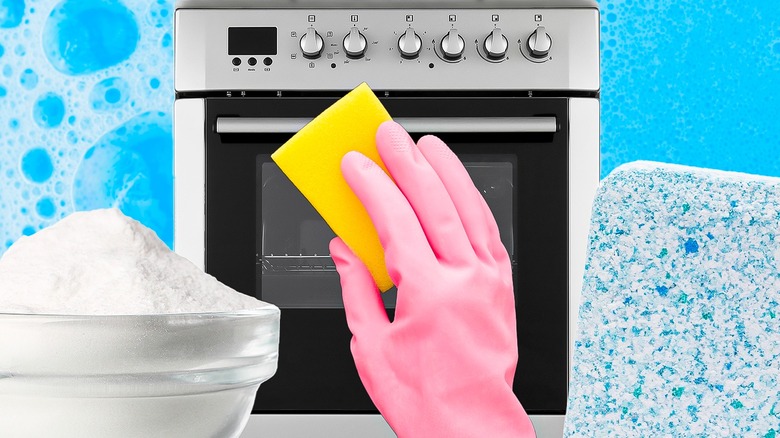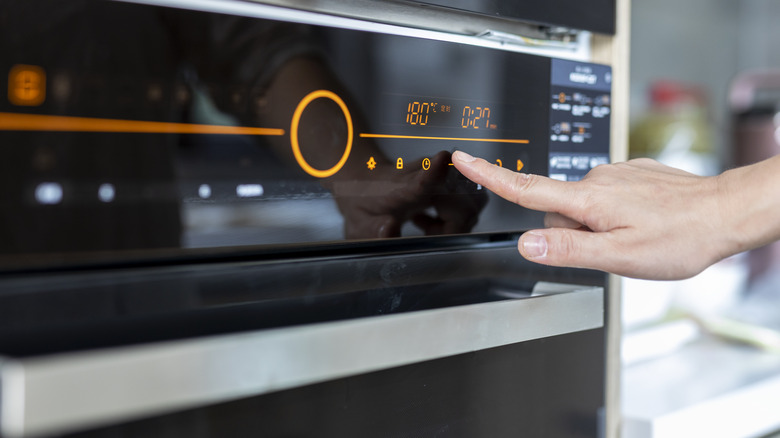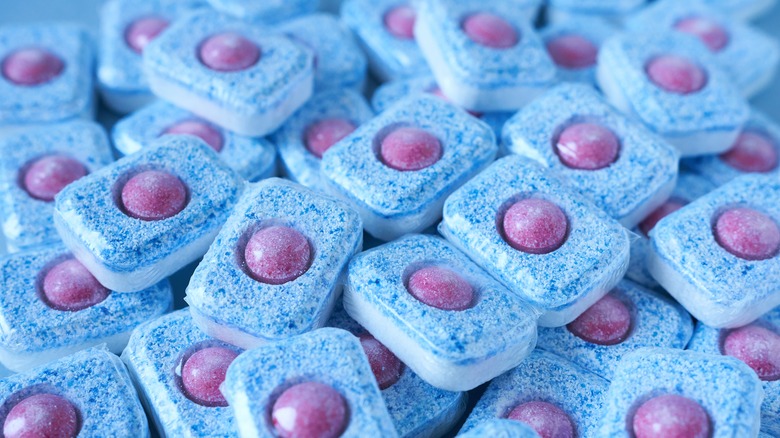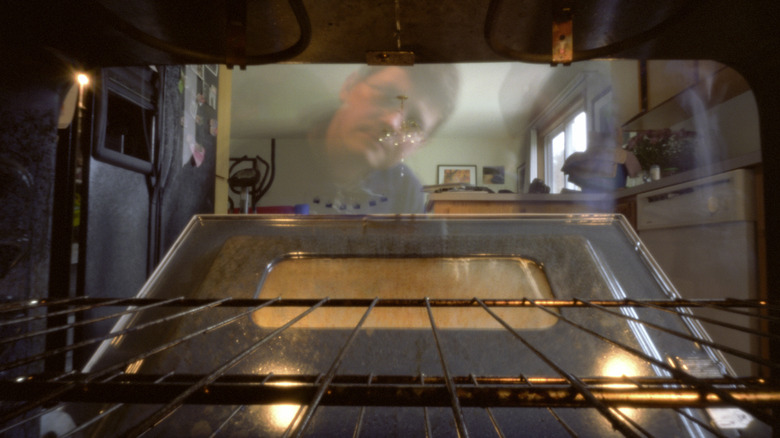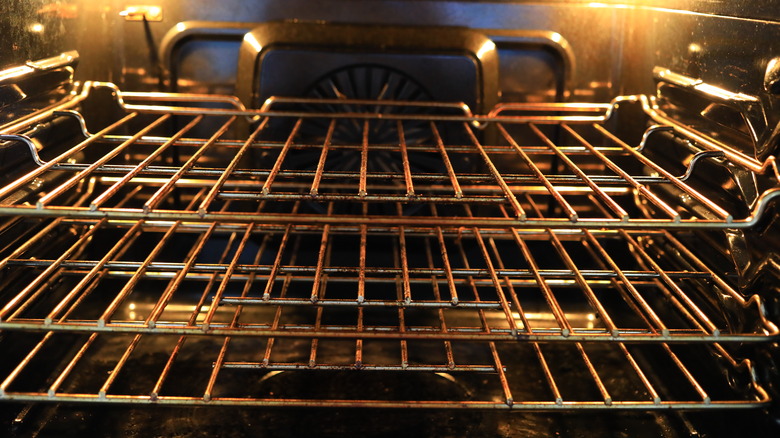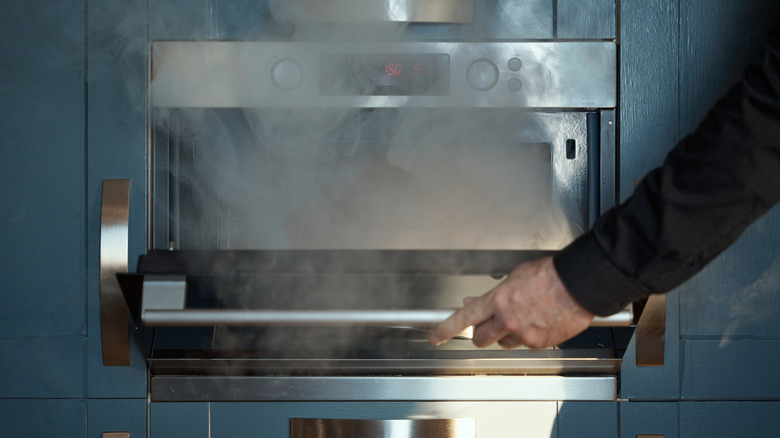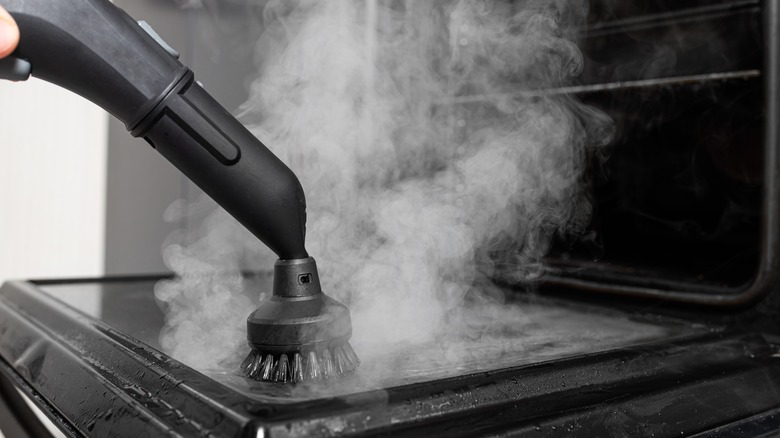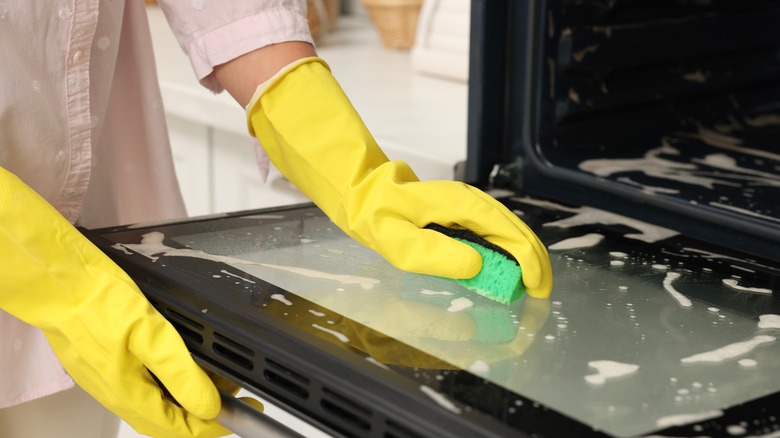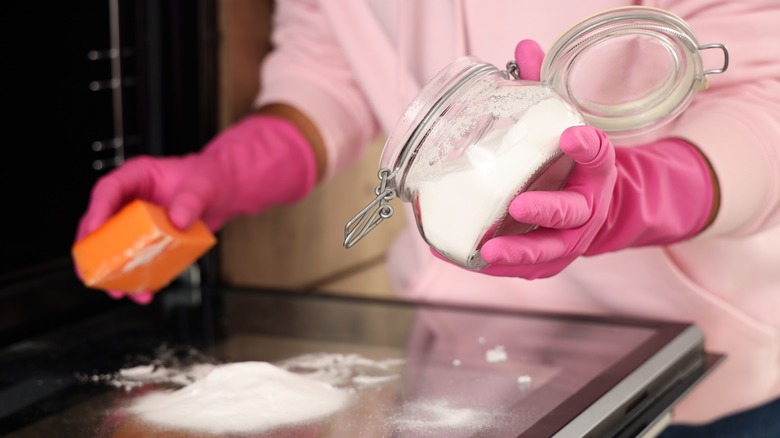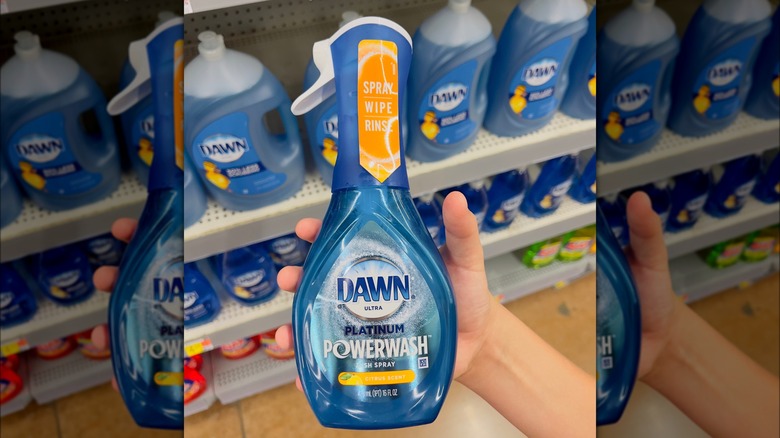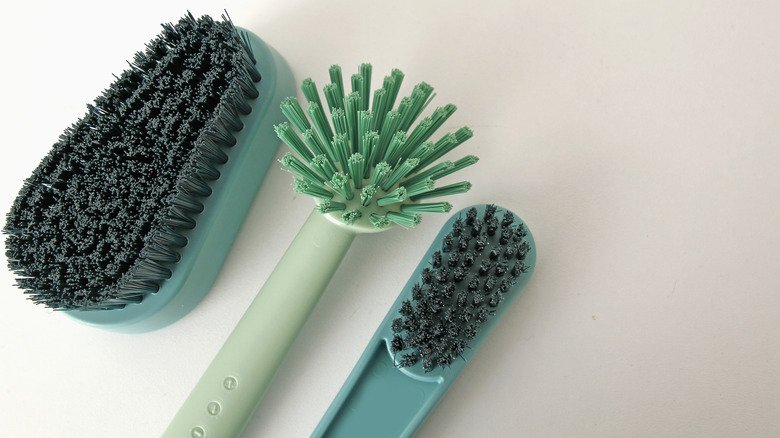10 Oven Cleaning Hacks You Need To Try ASAP
Raise your hand if you love cleaning your oven. Anyone? Yeah, we didn't think so. The hard truth is it's a tedious, time-consuming, and uncomfortable slog. Even if you use a powerful spray-on cleaner, you'll have to endure hours of unpleasant fumes while you wait for it to do its job — only to then get on your knees, stick your head in the oven, and use up piles of towels to clean it out. And then there's the fun of removing and cleaning the racks, which are too large and unwieldy to fit into most kitchen sinks.
Compounding the misery is the fact that most of us don't clean our ovens as often as we should, which leads to them getting thoroughly encrusted in burnt-on gunk. This, of course, makes us dread cleaning our ovens even more, leading to more procrastination and even more oven gunk. But cleaning every part of our oven is still necessary, as baked-on residue can contaminate food, contribute to odors, and cause damage.
So while no one can make oven cleaning fun, there are ways to make it less painful. We've enlisted four cleaning professionals — Toby Schulz, CEO of Maid2Match; Stanley Chen, owner of BerryClean; Delah Gomasi, CEO of MaidForYou; and Ronnie Kendrick, founder of CompanyClean – to share their tips to make the job easier.
Gently warm the oven before removing burned residue
Obviously, you don't want to stick your hand in the oven to start cleaning while the heat is still on or if the oven is still hot from your last meal. But as Toby Schulz shares, a bit of warmth in the oven can help soften tough residue and make it easier to remove. Thus, he advises against waiting until the oven is completely cold to clean up drips and splatters. "For baked-on food and grease, [wait until] your oven has cooled down to around 122 degrees Fahrenheit," he said. "Wear some rubber gloves and use a cooktop scraper or razor blade to scrape off any food residue while it's still warm."
Similarly, he advises us to warm our ovens gently if they have already gone cold. "If you're working from a cool oven (such as one that's been off for a long time), preheat your oven to 122 degrees Fahrenheit and switch it off. Wait a bit before going in with the scraper," he said. At this point, the oven will be warm enough to soften baked-on residue (like drippings from last night's macaroni and cheese), but cool enough to work in safely.
A dishwashing tablet can remove tough dirt
When cleaning our ovens, we've all encountered those maddening stains or burnt-on lumps that stubbornly refuse to go away, no matter how hard we scrub. (And no, we'll never stop making our yummy, messy favorites to prevent this. Those salted caramel-stuffed white chocolate chip cookies are totally worth it, even if they sometimes decide to leave a permanent souvenir on the oven floor.) Fortunately, intrepid cooks have found a solution. "There's also a hack that's gaining popularity — use a dishwasher tablet!" Toby Schultz said. "Dampen it in warm water (don't let it crumble, though) and use that to gently scrub the oven surfaces."
This hack may sound strange, but it's easy to see why it works. After all, dishwashing tablets are designed to handle the same types of dirt — baked-on grease and food residue — as oven cleaners. And their grainy, abrasive texture can also help loosen stuck-on gunk. To clean your oven with a damp dishwasher tablet, simply rub it over any dirty areas, re-moistening the tablet if it gets dry. Once the tablet has done its work, clean off any soapy residue with a damp cloth. The tablets work great not only on oven walls, but on your oven's glass window as well.
Don't overuse your self-cleaning function
If your oven has a self-cleaning function, it may feel like a godsend — no scrubbing, no contorting yourself into weird positions, no smelly cleaner fumes. Just take out the racks, close your oven, turn on the self-cleaning function, and in a few hours a clean oven will be yours. But while self-cleaning is super convenient and typically does a good job of removing burned-on dirt, the experts warn it's not the panacea oven manufacturers make it out to be.
For one, because self-cleaning works by cranking the oven heat up to 800 degrees to incinerate stuck-on residue, it can be hard on your oven. "We never recommend that our clients utilize the self-cleaning feature of their oven," Delah Gomasi said. "I've seen too many ovens that have been damaged because the self-cleaning feature malfunctioned and to repair the oven after a malfunction usually costs the total amount of the oven." Toby Schulz shares these concerns. "If you use the self-cleaning function of your oven, never leave it unattended for long," he said. "It raises the oven temp to extremely high levels, which creates a very real fire hazard. Constantly using the self-cleaning function can also damage the internal circuitry and mechanisms of the oven, lowering its lifespan and effectiveness." In addition, this high heat also generates plenty of smoke, so if you do use your self-cleaning function, keep a window open or a fan on.
Cover your bottom rack to catch drips
For passionate home cooks, oven cleaning is a more onerous burden than it is for our non-cooking friends. Those who make most of their meals in the microwave need not worry about grease drips from cooking bacon in the oven or barbecue sauce splatters. But those who bake or broil a lot know that messes in the oven are inevitable, no matter how tidy we try to be. And cooks who take pride in their work know this can be a problem as odors from a dirty oven can infiltrate the foods you bake in it.
While drips and spills are unavoidable, you can take steps to minimize them and their impact. "Put baking sheets, aluminum foil, or oven liners on the lower rack to catch any drips and spills from the food you're cooking," Toby Schulz said. "This will help minimize food residue and grease build-up in the oven." He warns, however, against the practice of covering the floor of the oven. "Note that it should be [on] the lower rack and not the bottom of the oven. Putting foil at the bottom could block the vents and heating, and the foil itself could get scorched," he said.
Use a razor to scrape off burnt-on gunk
It's no secret how stubborn oven dirt can be. Almost always, you will encounter stains or patches of residue that no number of wet towels can conquer. To deal with these, you will require more serious weaponry. As Toby Schulz shared, a good first step is to ensure the oven is slightly warm when you start cleaning. The stubborn gunk will soften in the heat and be easier to remove. A second step, he said, is to use the right tools for the task. "Use a cooktop scraper or razor blade to scrape off any food residue while it's still warm," he said.
Note, however, that hard tools such as these can be tough on your oven, so use them carefully and also have gentler options on hand to clean up looser residue. "A handy tool for deep cleaning your oven is a nylon oven cleaning brush," Stanley Chen said. "Its flexible bristles are excellent for reaching crevices and scrubbing away residue without scratching the oven's surface."
Weekly steam cleaning can keep dirt from building up
We all dread oven cleaning. But the hard reality is it's unavoidable unless we're okay baking a boxed mix cake that smells like a burnt version of last week's baked salmon. And the experts share yet another unavoidable truth: the best way to make the job easier is to do it more often. "To keep your oven in pristine condition with frequent use, establish a routine of cleaning it every month," Stanley Chen said. "This regular upkeep prevents grease and food residues from becoming stubborn and time-consuming to remove."
To keep dirt and grease at bay between cleanings, Toby Schulz recommends weekly steam cleanings. "You can steam clean your oven after use (or every week) by filling an oven-safe container (ideally not glass) with 4-8 cups of water with half a cup of vinegar," he said. "Preheat your oven to 250 degrees Fahrenheit, put the container on the lower rack, and shut the door. The steam will help loosen the surface dirt and grease." In addition, some ovens come with a steam cleaning function. While not a substitute for a thorough cleaning, they can loosen oven residue before it gets firmly stuck.
Wear PPE when working with oven cleaning sprays
Spray-on cleaners have their haters, but most of us continue to use them around because they work. Even the pros stand by them. "Spray-on oven cleaner, such as Easy-Off, is both effective and safe when used correctly, and our cleaners at BerryClean swear by it," Stanley Chen said. "It tackles stubborn grease and grime with ease, helping restore your oven to its sparkling best." But their power comes with responsibility. Sprays strong enough to dissolve burnt-on grease and food can also do a number on your skin. So your job when using them is to coat the inside of your oven without getting any of it on yourself.
The experts recommend caution when using these cleaners. "To ensure safety, always follow the manufacturer's instructions, wear protective gloves, and ensure good ventilation while cleaning," Chen said. Delah Gomesi takes these measures a step further. "We always ensure that our cleaners are utilizing appropriate PPE when using spray-on oven cleaners," he said. "This includes protective goggles, gloves, and long sleeves to make sure they don't get any of the corrosive product on their skin." Also, be aware that these cleaners can damage other surfaces in your kitchen. "We also utilize drop sheets to cover kitchen floors to make sure that the spray-on cleaner doesn't come into contact with any sensitive fixtures like wooden floors or natural stone bench tops," Gomesi said.
Baking soda is an odor-free alternative to oven cleaner
As mentioned, spray-on oven cleaners are popular for a reason; they're simple to use and they do the job. "In terms of effectiveness, I've found spray-on oven cleaner to be the best bang for your buck," Delah Gomasi said. "It's effective, easy to use, and most spray-on oven cleaners allow you to effectively apply the cleaner, wait for 20 odd minutes, and then wipe clean even the most dirty of ovens."
The downside is these cleaners can be smelly and harmful if inhaled or ingested, which can be deal-breakers for those who are sensitive to odors or uncomfortable with the idea of caustic chemicals in their homes. "A safer and effective alternative to spray-on oven cleaners is baking soda [and] vinegar," Ronnie Kendrick said. "Mix 1/2 cup of baking soda with a few tablespoons of water to make a thick paste. With gloves on, spread the paste inside the oven and let it sit for 12 hours or overnight. Then, wipe it down with a damp sponge. Spray white vinegar inside to react with any leftover baking soda, let it foam, and wipe it clean. Repeat with vinegar if needed to get rid of all residue. It's a powerful, non-toxic way to get your oven sparkling clean!"
Dawn Powerwash is another fume-free alternative
If you prefer to avoid spray-on oven cleaners but still want something a little stronger than baking soda, you can also find several fume-free alternatives in stores. "Look into cleaning pastes or gel and cream formulas, which you can apply with a damp sponge or cloth," Toby Schulz said. "They'll need more elbow grease to get rid of your oven grease, but [there is] no spraying involved. There are also powder-based cleaners that typically require water or a damp cloth to activate, then you can scrub the oven clean."
In addition, you can also make use of cleaners that weren't designed specifically to clean ovens but can still do the job well. "Many homeowners swear by Dawn Powerwash," Schulz said. "You can use the powerful cleaning spray to clean your oven, and it works quickly. Plus, no scrubbing is necessary. Just spray it on, then wipe it off." He likes other items from the cleaning aisle as well. "Some cleaning sponges (or magic erasers) are convenient for spot-cleaning or removing gunk from oven doors," he said.
Use flexible brushes or pipe cleaners on tough-to-reach areas
One of the many vexing things about oven cleaning is the number of hard-to-reach spots, such as the back corners, the top of the oven, and the areas near and under the heating elements. While you can just spray the other areas with cleaner, wipe it off, and consider the job done, these trouble spots require a lot more attention and elbow grease. Adding to the challenge is the fact that you need to keep cleaning solutions away from many of these sensitive areas. "Avoid getting any cleaner (spray-type or otherwise) on the pilot light or heating elements," Toby Schulz said. "These are delicate components and damaging them could mean a hefty repair bill or a malfunctioning oven."
To get around this problem, Schulz recommends gel or paste cleaners that stick more easily to the top of the oven and other problem spots without dripping. He also recommends brushes that can fit into tight spaces. "Flexible brushes (like pipe cleaners) can help you brush dirt out from places like the base of the oven door," he said.
